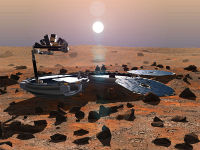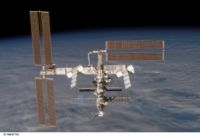Solar panel

The term Solar Panel stands for a variety of technologies to collect solar power and transform it to other kinds of [[energy].
Photovoltaics generate electric energy out of sunlight. Usually they are constructed from a semi-conductor such as silicon. Photovoltaic panels are frequently used in space primarily for satellites and space stations in Earth orbit and is the prime source of energy for Mars satellites, landers and rovers.
Sun-powered water splitter generate hydrogen and oxygen directly from sunlight.[1] This is an emerging technology with the chance of high efficient energy generation in combination with energy storage.
Solar panels begin to lose usefulness for deep space and outer solar system missions (i.e. the Cassini mission to Saturn or the Voyager program) where radioisotope thermoelectric generators are the favoured (if controversial) means to generate electricity.

On Mars the sunlight is bright enough to use solar panels. The famous rovers Spirit and Opportunity have them. The experiences are terrific: Since July 2003 they are working fine, and the Martian winds have kept the surfaces clear of dust. However, the rovers cannot operate at full capacity during the Martian winter when the intensity of the sunlight is reduced, and dust storms have from time to time caused severe reductions in the available power, requiring the rovers to go into a low-power "hibernation" mode.
Solar concentrators increase the efficiency of solar panels by focusing the sunlight.
A major drawback to using solar power is the requirement for some form of energy storage to keep power available during the Martian night.
Contents
Net energy gain (NEG)
The wear lifespan of photovoltaic cells must be considered. Due to the higher radiation damage on Mars, compared with a terrestrial environment, the wear lifespan is shorter. Variations in solar activity can cause an even stronger degradation in years with a maximum solar activity.
The degradation can be partly mitigated by a number of methods:
- Selection of material. Some are less prone to radiation damage than others.
- Filtering of the radiation by additional absorbing layers.
- Placing the solar panel underground and directing light to it by mirror through an angled tunnel.
The production of photovoltaic cells consumes an amount of energy. This amount must be taken into account to find out, whether or not photovoltaic cells can be a long term source of energy. With current technology the breakeven energy payback time is about 2 to 4 years. Thin film cells have a better NEG than crystalline cells, for they consume less energy during the production process. A positive NEG is one of the crucial issues in planning an autonomous colony.
Dust Accumulation
The vulnerability of solar panels to windblown dust has been well demonstrated. Over time, a panel may be covered completely. Methods must be developed to remove this dust or prevent its accumulation in the first place. Near a settlement, humans or robots may remove this dust. Panels in outlying locations must be cleaned automatically.
Prevention
Prevention is typically more energy efficient than removal, though both are needed.
Location
Proper location of the panels is the first step in preventing dust accumulation. Low lying areas should be avoided, as should the leeward side of structures and rocks.
Angle
If panels are stationary, they should be installed at an angle. If they are motorized, they should be oriented perpendicular to the ground at night and during dust storms. This allows gravity to pull the dust off the panels.
Dust Covers
Dust covers can be deployed over the panels at night or during dust storms.
Removal
Dust may be removed by several means. Care must be given not to scratch the surface of the panel during removal.
Blown Air
Air movement seems to pose the least risk of damage to the panels themselves. This may be accomplished with simple bellows or fans. If fans are used, due to build-up of dust miniparticles (caused mostly by static electricity) it may still require aditional care in long term.
Brushing
The use of a brush or a rubber squeegee (what is the international term for this?) would be more energy efficient than blown air, but poses a greater risk of damage to the panel. A brushing mechanism could be installed along with the panels, and programmed to clean on command, or upon detection of decreased energy output.
External links
- U.S. Department of Energy: What is the energy payback for PV?
- Wiley InterScience: Photovoltaics Energy Payback Times, ...
- NASA: International Space Station Solar Array Wing On-Orbit Electrical Performance Degradation Measured
- U.S. Department Of Defense: Radiation Hardening of Solar Cells and Arrays
- NASA: The viability of photovoltaics on the Martian surface
- NASA ADS: Photo-recovery of electron-irradiated GaAs solar cells
- ... more NASA reports upon degradation
Open issues
- By which factor is the wear lifespan of photovoltaic cells shorter, compared with a terrestrial environment? What is the exact NEG for a Martian environment?






